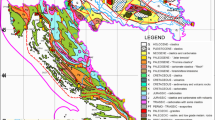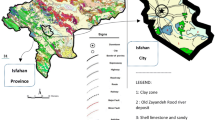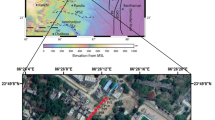Abstract
Northwest Himalaya is one of the seismically active regions that had experienced a number of major and moderate earthquakes in the past. The 4th April 1905 Kangra earthquake (Ms 7.8) is one amongst those which had caused a devastating effect to the built environment, as a consequence of amplification factor due to varied impedance contrast between the overlying alluvial soil and underlying bedrock. Preventive actions aimed at minimizing the economic losses caused by such events require estimation of dynamic characteristics of the surface soil and its behaviour under strong motion excitation. Under this initiative, the Kangra Valley, which falls in seismic zone IV and V, was extensively studied to elucidate the effects of earthquake excitation on the built environment due to the soil amplification. The Kangra Valley is characterized by the presence of hills and valleys, thus has a very high variation in the sediment thickness above bedrock which is an important parameter for seismic hazard assessment. This study aims to establish a new empirical relationship from the experimental data for estimating sediment thicknesses of the Kangra Valley. Under this initiative the resonance frequency has been calculated from ambient noise measurement from 200 sites of the Kangra Valley. This extensive survey allowed the estimation of resonance frequencies (4–20 Hz) in the region and identified the areas prone to site amplification. Furthermore, joint-fit-inversion modelling of horizontal to vertical spectral ratio (HVSR) and dispersion curves obtained from ambient noise measurement and multichannel simulation with one receiver (MSOR) data acquisition, respectively, led to 1-D shear wave velocity (Vs) profile. New empirical relationships were established for Kangra Valley to estimate the thickness of overburden using non-linear regression analysis between resonance frequency (f0) obtained by HVSR technique and pseudo-depth (H) from the study area. The equation provides an effective tool to detect sediment thicknesses in the area with similar geological setup. The methods described in the study apply a new approach to derive new empirical relationship in hilly terrain and the area with sparse borehole record.










Similar content being viewed by others
References
Al Yuncha Z, Luzon F (2000) On the horizontal-to-vertical spectral ratio in sedimentary basins. Bull Seism Soc Am 90(4):1101–1106
Ambraseys NN, Douglas J (2004) Magnitude calibration of north Indian earthquakes. Geophys J Int 159(1):165–206. https://doi.org/10.1111/j.1365-246X.2004.02323.x
Bindi D, Parolai S, Spallarossa D, Catteneo M (2000) Site effects by H/V ratio: comparison of two different procedures. J Earthq Eng 4(1):97–113. https://doi.org/10.1080/13632460009350364
Birgoren G, Ozel O, Siyahi B (2009) Bedrock depth mapping of the Coast South of İstanbul: comparison of analytical and experimental analyses. Turkish J Earth Sci 18:315–329. https://doi.org/10.3906/yer-0712-3
BIS (2002) IS:1893–2002: criteria for earthquake resistant design of structure. Bureau of Indian Standards, New Delhi
Bonnefoy-Claudet S, Cotton F, Bard PY (2006) The nature of noise wavefield and its applications for site effects studies. A literature review. Earth Sci Rev 79:205–227. https://doi.org/10.1016/j.earscirev.2006.07.004
Castellaro S (2016) The complementarity of H/V and dispersion curves. Geophysics 81(6):323–338. https://doi.org/10.1190/GEO2015-0399.1
Castellaro S, Mulargia F (2009) VS30 estimates using constrained H/V measurements. Bull Seismol Soc Am 99:761–773. https://doi.org/10.1785/0120080179
Chan CH, Wang Y, Almeida R, Yadav RBS (2017) Enhanced stress and changes to regional seismicity due to the 2015 Mw 7.8 Gorkha, Nepal, earthquake on the neighbouring segments of the main Himalayan thrust. J Asian Earth Sci 133(1):46–55. https://doi.org/10.1016/j.jseaes.2016.03.004
Dey S, Thiede RC, Schildgen TF, Wittmann H, Bookhagen B, Scherler D, Strecker MR (2016) Holocene internal shortening within the northwest Sub-Himalaya: out-of-sequence faulting of the Jwalamukhi thrust, India. Tectonics 35:2677–2697. https://doi.org/10.1002/2015TC004002
Fah D, Kind F, Giardini D (2001) A theoretical investigation of average H/V ratios. Geophys J Int 145(2):535–549. https://doi.org/10.1046/j.0956-540x.2001.01406.x
Gabas A, Macau A, Benjumea B, Bellmunt F, Figueras S, Vila M (2014) Combination of geophysical methods to support urban geological mapping. Surv Geophys 35:983–1002. https://doi.org/10.1007/s10712-013-9248-9
Gautam D (2017) Unearthed lessons of 25 April 2015 Gorkha earthquake (MW 7.8): geotechnical earthquake engineering perspectives. Geomat Nat Haz Risk 8(2):1358–1382. https://doi.org/10.1080/19475705.2017.1337653
Gupta RK, Agrawal M, Pal SK, Kumar R, Srivastava S (2019) Site characterization through combined analysis of seismic and electrical resistivity data at a site of Dhanbad, Jharkhand. India Environ Earth Sci 78:226. https://doi.org/10.1007/s12665-019-8231-2
Harutoonian P, Leo CJ, Tokeshi K, Doanh T, Castellaro S, Zou JJ, Liyanapathirana DS, Wong H (2013) Investigation of dynamically compacted ground by HVSR-based approach. Soil Dyn Earthq Eng 46:20–29. https://doi.org/10.1016/j.soildyn.2012.12.004
Ibs-von Seht MIV, Wohlenberg J (1999) Microtremor measurements used to map thickness of soft sediments. Bull Seismol Soc Am 89(1):250–259
Jayangondaperumal R, Kumahara Y, Thakur VC et al (2017) Great earthquake surface ruptures along backthrust of the Janauri anticline, NW Himalaya. J Asian Earth Sci 133:89–101. https://doi.org/10.1016/j.jseaes.2016.05.006
Kanai K (1961) An empirical formula for the spectrum of strong earthquake motions. Bull Earthq Res Inst Univ Tokyo 39:85–95
Kanai K, Tanaka T (1961) On microtremors. VIII Bull Earthq Res Inst 39:97–114
Konno K, Ohmachi T (1998) Ground-motion characteristics estimated from spectral ratio between horizontal and vertical components of microtremor. Bull Seism Soc Am 88(1):228–241
Kramer SL (1996) Geotechnical Earthquake Engineering, 1st edn. Prentice Hall, Upper Saddle River, p 653
Lin S, Ashlock JC (2016) Surface-wave testing of soil sites using multichannel simulation with one-receiver. Soil Dyn Earthq Eng 87:82–92. https://doi.org/10.1016/j.soildyn.2016.04.013
Lunedei E, Malischewsky P (2014) A review and some new issues on the theory of the H/V technique for ambient vibrations. Geotech Geol Earthq Eng 34:371–394. https://doi.org/10.1007/978-3-319-07118-3
Mahajan AK (2009) NEHRP soil classification and estimation of 1-D site effect of Dehradun fan deposits using shear wave velocity. Eng Geol 104:232–240. https://doi.org/10.1016/j.enggeo.2008.10.013
Mahajan AK, Kumar S (1994) Linear features registered on the Landsat imagery in the Dharamsala-Palampur area NW Himalaya, vis-à-vis seismic status of the area. Geophysika II:15–25
Mahajan AK, Kumar P (2018) Site characterisation in Kangra Valley (NW Himalaya, India) by inversion of H/V spectral ratio from ambient noise measurements and its validation by multichannel analysis of surface waves technique. Near Surf Geophys 16(3):314–327. https://doi.org/10.3997/1873-0604.2018008
Mahajan AK, Kumar N, Arora BR (2006) Quick isoseismal map of 8th October, 2005 Kashmir earthquake. Curr Sci 91(3):356–361
Mahajan AK, Thakur VC, Sharma ML, Chauhan M (2010) Probabilistic seismic hazard map of NW Himalaya and its adjoining area, India. Nat Hazards 53:443–457. https://doi.org/10.1007/s11069-009-9439-3
Middlemiss CS (1910) The Kangra earthquake of 4th April, 1905. Mem Geol Surv India 38:1–409
Mucciarelli M, Gallipoli MR (2001) A critical review of 10 years of microtremor HVSR technique. Boll Geofis Teor Appl 42(3–4):255–266
Nakamura Y (1989) A method for dynamic characteristics estimation of subsurface using microtremor on the ground surface. Q Rep Railw Tech Res Inst 30(1):25–33
Nakamura Y (2000) Clear identification of fundamental idea of Nakamura’s technique and its application. In: Proceedings of the 12th world conference on earthquake engineering, Auckland, New Zealand, pp 8
Nogoshi M, Igarashi T (1971) On the amplitude characteristics of microtremor (part 2). J Seismol Soc Japan 24:26–40
Ori GG, Friend PF (1984) Sedimentary basins formed and carried piggyback on active thrust sheets. Geol 12:475–478. https://doi.org/10.1130/0091-7613(1984)12%3c475:SBFACP%3e2.0.CO;2
Ozalaybey S, Zor E, Ergintav S, Tapırdamaz MC (2011) Investigation of 3-D basin structures in the İzmit Bay area (Turkey) by single-station microtremor and gravimetric methods. Geophys J Int 186:883–894. https://doi.org/10.1111/j.1365-246X.2011.05085.x
Park CB, Miller RD, Xia J (1999) Multichannel analysis of surface waves. Geophysics 64(3):800–808
Parolai S, Bormann P, Milkereit C (2002) New relationships between vs, thickness of sediments, and resonance frequency calculated by the H/V ratio of seismic noise for the cologne area (Germany). Bull Seismol Soc Am 92(6):2521–2527
Paudyal YR, Yatabe R, Bhandary NP, Dahal RK (2012) A study of local amplification effect of soil layers on ground motion in the Kathmandu Valley using microtremor analysis. Earthq Eng Eng Vib 11(2):257–268. https://doi.org/10.1007/s11803-012-0115-3
Paudyal YR, Yatabe R, Bhandary NP, Dahal RK (2013) Basement topography of the Kathmandu Basin using microtremor observation. J Asian Earth Sci 62:627–637. https://doi.org/10.1016/j.jseaes.2012.11.011
Rezaei S, Choobbasti AJ (2017) Application of the microtremor measurements to a site effect study. Earthq Sci 30(3):157–164. https://doi.org/10.1007/s11589-017-0187-2
Rezaei S, Choobbasti AJ, Kutanaei SS (2013) Site effect assessment using microtremor measurement, equivalent linear method, and artificial neural network (case study: Babol, Iran). Arab J Geosci 8(3):1453–1466. https://doi.org/10.1007/s12517-013-1201-1
Rix GJ, Leipski EA (1991) Accuracy and resolution of surface wave inversion. In: Bhatia SK, Blaney GW (eds) Recent advances in instrumentation, data acquisition and testing in soil dynamics. American Society of Civil Engineers, Reston, pp 17–32
Roser J, Gosar A (2010) Determination of Vs30 for seismic ground classification in the Ljubljana area, Slovenia. Acta Geotech Slov 7:61–76
Ryden N, Park CB, Ulriksen P, Miller RD (2004) Multimodal approach to seismic pavement testing. J Geotech Geoenviron Eng 130:636–645. https://doi.org/10.1061/(ASCE)1090-0241(2004)130:6(636)
Sah MP, Srivastava RAK (1992) Morphology and facies of the alluvial-fan sedimentation in the Kangra Valley. Himachal Himalaya Sediment Geol 76(1–2):23–42
SESAME (2004) Guidelines for the implementation of the H/V spectral ratio technique on ambient vibrations, Rapport final
Tarabusi G, Caputo R (2016) The use of HVSR measurements for investigating buried tectonic structures: the Mirandola anticline, Northern Italy, as a case study. Int J Earth Sci 106:341–353. https://doi.org/10.1007/s00531-016-1322-3
Te CC, Chang SC, Wen KL (2017) Stochastic ground motion simulation of the 2016 Meinong, Taiwan earthquake. Earth Planets Sp 69:62. https://doi.org/10.1186/s40623-017-0645-z
Thakur VC, Joshi M, Sahoo D, Suresh N, Jayangondapermal R, Singh A (2014) Partitioning of convergence in Northwest sub-Himalaya: estimation of late Quaternary uplift and convergence rates across the Kangra reentrant, North India. Int J Earth Sci 103:1037–1056. https://doi.org/10.1007/s00531-014-1016-7
Tokeshi K, Harutoonian P, Leo CJ, Liyanapathirana S (2013) Use of surface waves for geotechnical engineering applications in Western Sydney. Adv Geosci 35:37–44. https://doi.org/10.5194/adgeo-35-37-2013
Tun M, Pekkan E, Ozel O, Guney Y (2016) An investigation into the bedrock depth in the Eskisehir Quaternary Basin (Turkey) using the microtremor method. Geophys J Int 207(1):589–607. https://doi.org/10.1093/gji/ggw294
Acknowledgements
The authors are thankful to Central University of Himachal Pradesh (CUHP) for providing basic logistic. The financial grant provided by the Ministry of Earth Sciences, Govt. of India, under the project no. MoES/P.O.(Seismo)/1(206)/2013 is thankfully acknowledged. The authors also acknowledge the feedback and constructive input from two anonymous reviewers.
Author information
Authors and Affiliations
Corresponding author
Additional information
Publisher's Note
Springer Nature remains neutral with regard to jurisdictional claims in published maps and institutional affiliations.
Rights and permissions
About this article
Cite this article
Kumar, P., Mahajan, A.K. New empirical relationship between resonance frequency and thickness of sediment using ambient noise measurements and joint-fit-inversion of the Rayleigh wave dispersion curve for Kangra Valley (NW Himalaya), India. Environ Earth Sci 79, 256 (2020). https://doi.org/10.1007/s12665-020-09000-8
Received:
Accepted:
Published:
DOI: https://doi.org/10.1007/s12665-020-09000-8




